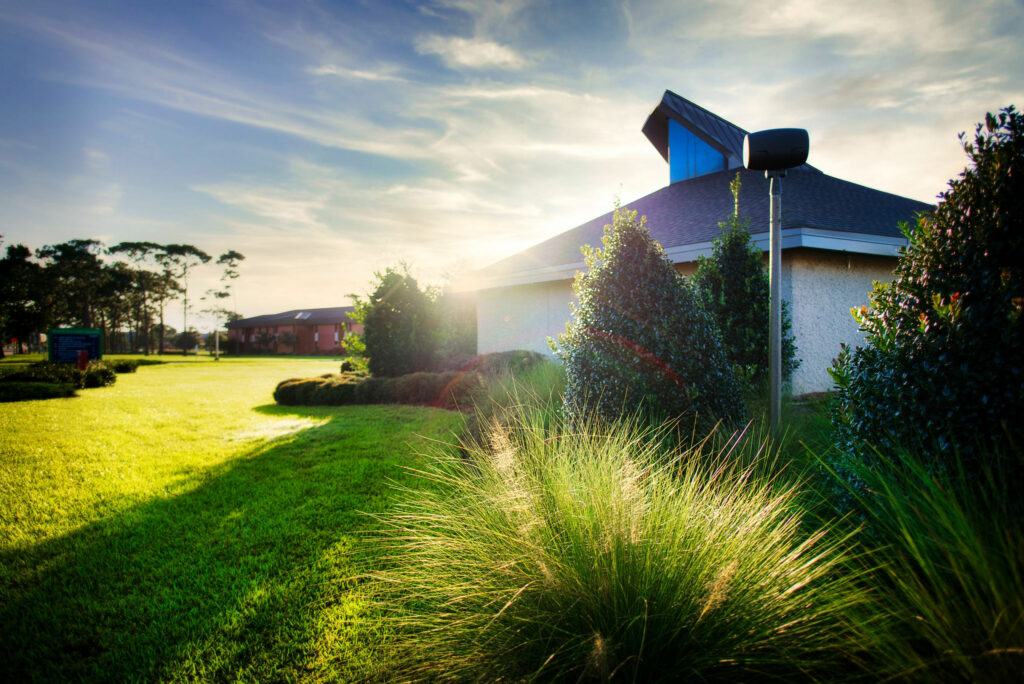Golfweek Features Jerry Pate Design and Teeth of the Dog - Read More
It’s always enjoyable to watch nature take its course in spring. Daffodils and other bulbs burst forth, trees begin to bloom and everything starts to look a little greener, including the grass. Turf wakes up on its own when temperatures rise and days get longer, but usually can use a little help to face the summer looking and feeling its best. Let’s talk spring turf maintenance!

Cleanup, Assess and Repair
Now is a good time to take a good look at the condition of green spaces and clean up any areas that were neglected over the winter. Remove any branches or trimmings that may have accumulated. Inspect the condition of the grass, looking for any bare spots, weedy areas or damage. In Northern climates it may be necessary to repair areas that have been damaged by snow removal, salt application or winter foot traffic.
Treat Any Lingering Diseases
Unfortunately, cold weather isn’t very hard on the diseases that affect our lawns. If disease is present, spring is a great time to treat it, especially before fertilizer application that can actually feed the fungi as well as the grass.
Some common turf diseases include:
- Dollar Spot – small diameter circular patches of brown or straw-colored grass and yellow or reddish-brown spots on individual blades of grass. Dollar Spot can be prevented by less frequent watering, dethatching and the addition of nitrogen. Fungicides are used for treatment.
- Take-All Root Rot – larger patches several feet in diameter of wilting and browning grass with dark brown roots. Root Rot can be controlled with acid-rich fertilizers, phosphorus and potash. Improved drainage and dethatching will also help. Treat with fungicides.
- Brown Patch – similar in appearance to Root Rot, with patches up to 25 feet in diameter. Avoid the use of nitrogen when Brown Patch is active and be sure the pH is correct. Use fungicides for treatment.
- Rust – thinning grass with yellow flecks on individual blades. Water less frequently and do it early in the day so moisture doesn’t remain on the blades as long. Use fungicides for treatment.
More common turf diseases:
- Leaf Spot – bruise like spots on individual blades of grass, shriveling leaves and thinning turf. Minimize by watering less frequently, decreasing traffic and equipment use and removing thatch.
- Anthracnose – irregularly shaped patches of yellow or brown grass, yellow leaf spots with black centers and stem and leaf rot resulting in grass that is easy to pull up. Minimize foot traffic, decrease watering and do not aerate. Fungicides will not cure the infected area, but may be used for prevention.
- Slime Mold – spores coating grass in small diameter circular areas. Spores can be washed off and Slime Molds will typically disappear on their own in a few weeks.
- Pythium Root Rot – Irregular patches of yellowing, thinning and slow-growing grass. Apply nitrogen, phosphorus and potash. Limit watering and mowing when the disease is active. Fungicides may be used for severe infections.
As you can see from the list above, lawn diseases and their cures come in many varieties. Spring may be a good time to consult a professional service to make sure your turf gets off to the right start.
Control Pests
Pests are another threat to the health of your turf. Spring turf maintenance should include some preventative measures. Some of the common pests seen in spring are white grub worms, billbugs and chinch bugs. The type of insects you’ll likely find will depend a lot on the type of grass you have. White grub worms are found in most turf grasses, chinch bugs are more likely in St. Augustine grass and billbugs in zoysia grass.
A broad spectrum insecticide can help control most turf pests. Liquid products can be sprayed on, while granular insecticides must be watered in so that they effectively soak into the soil.
Control Weeds
Address weed control early in the year as well. Annual cool-season weeds like chickweed, henbit, bluegrass and swinecress will die off on their own in late spring when temperatures get warmer. Perennial cool-season weeds like dandelion, clover and wild garlic will require an herbicide to get them under control.
Apply a post-emergent herbicide for the cool season weeds that are already sprouting in the spring. Follow the manufacturer’s directions for application and don’t overdo it. Too much only goes to waste and is bad for the environment. Following up with a pre-emergent herbicide will help to prevent warm-season weeds from taking over in the summer season.
Test the Soil
Even when diseases, pests and weeds are under control, turf still depends on healthy and fertile soil to keep it looking beautiful. Your local extension office is a good option for testing and commercial test kits are also available. Results will give you good information about what your soil needs in the way of amendments or fertilizer. The information is invaluable to provide the best growing conditions for your grass. You can also avoid time and money wasted on unneeded products.
Fertilize
Spring is a great time to fertilize. That said, wait until the turf is nice and green and is actively growing for the year. Fertilizing before the grass has started growing is of no benefit.
A slow-release nitrogen fertilizer is a great option and will provide for steady growth well into summer. This is a spring turf maintenance must! Fast-release options may provide a quicker boost, but can also result in burning or growth that is too rapid due to higher levels of nitrogen. Use a spreader to avoid streaks or patchy growth from uneven fertilizer application.
Maintenance
Wait until grass is about 2 inches in height before mowing in the spring. Mowing too early can adversely affect growth when grass hasn’t had enough time to establish a strong foundation for the season. Mow grass a few times and then dethatch. Avoid aerating in the spring, as the resulting holes make perfect places for weed seeds to propagate.
Water and Maintain Irrigation Systems
Spring is an important time to give irrigation systems a thorough inspection. Replace any broken or failing components before the need for watering becomes critical. Typically, turf won’t require much watering in the spring. Too much water promotes shallow root growth, fungi and pests. 1 inch of water per week will be sufficient through the rest of spring.
Enjoy Lush, Green Grass!

We hope these tips can get you off to the right start on healthy, green turf this spring. A little work and attention will yield the results you are looking for. Engaging a professional landscape contractor can certainly help if this all seems a little daunting. Whatever path you choose, enjoy your lawn this summer!

